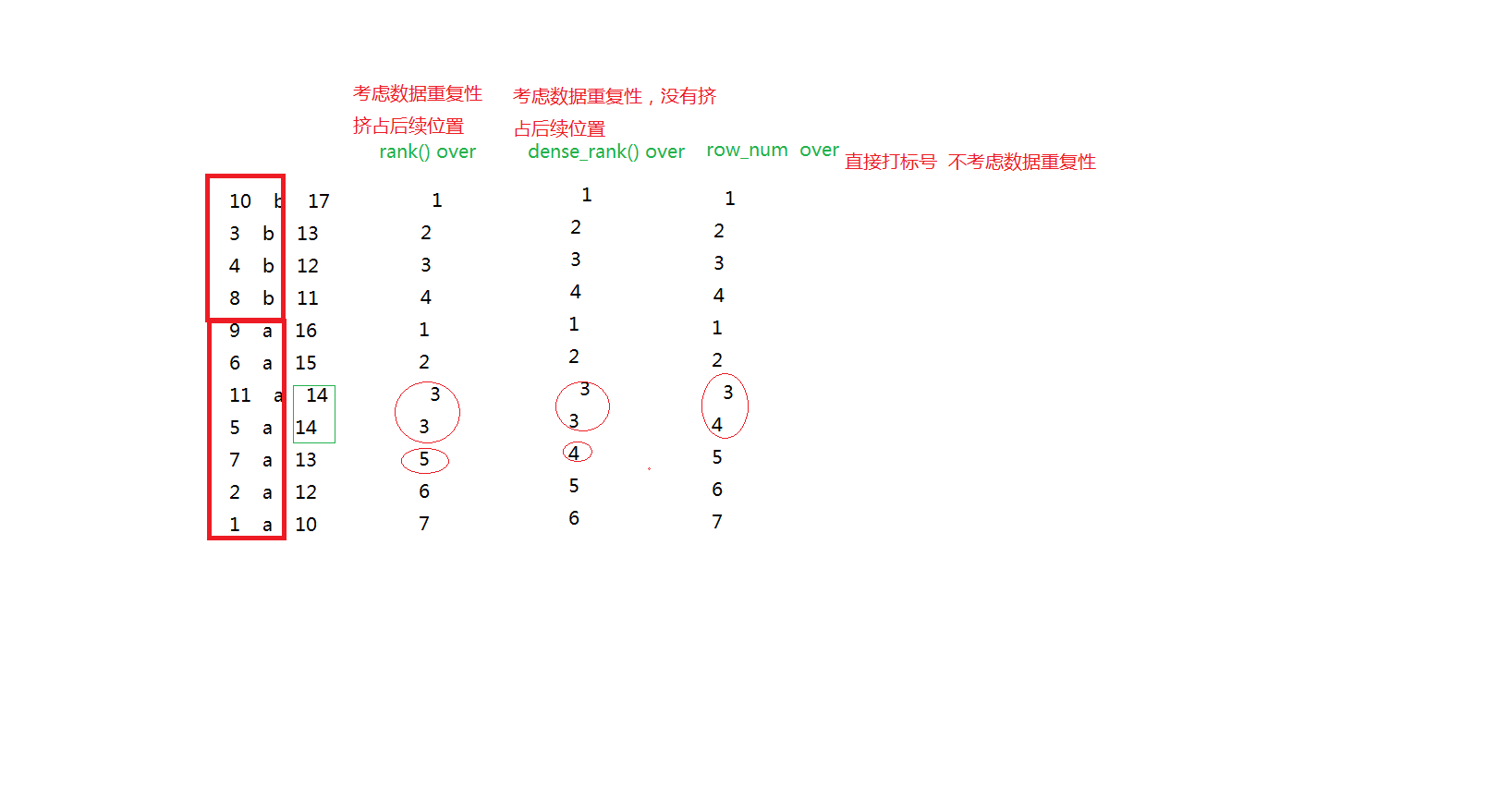Hive的内置函数
定义:
UDF(User-Defined-Function),用户自定义函数对数据进行处理。
UDTF(User-Defined Table-Generating Functions) 用来解决 输入一行输出多行(On-to-many maping) 的需求。
UDAF(User Defined Aggregation Function)用户自定义聚合函数,操作多个数据行,产生一个数据行。
用法:
1、UDF函数可以直接应用于select语句,对查询结构做格式化处理后,再输出内容。
2、编写UDF函数的时候需要注意一下几点:
a)自定义UDF需要继承org.apache.hadoop.hive.ql.UDF。
b)需要实现evaluate函。
c)evaluate函数支持重载。
hive的本地模式:
大多数的Hadoop job是需要hadoop提供的完整的可扩展性来处理大数据的。不过,有时hive的输入数据量是非常小的。在这种情况下,为查询出发执行任务的时间消耗可能会比实际job的执行时间要多的多。对于大多数这种情况,hive可以通过本地模式在单台机器上处理所有的任务。对于小数据集,执行时间会明显被缩短。
如此一来,对数据量比较小的操作,就可以在本地执行,这样要比提交任务到集群执行效率要快很多。
配置如下参数,可以开启Hive的本地模式:
hive> set hive.exec.mode.local.auto=true;(默认为false)

当一个job满足如下条件才能真正使用本地模式:
1.job的输入数据大小必须小于参数:hive.exec.mode.local.auto.inputbytes.max(默认128MB)
2.job的map数必须小于参数:hive.exec.mode.local.auto.tasks.max(默认4)
3.job的reduce数必须为0或者1
hive 中窗口函数row_number,rank,dense_ran,ntile分析函数的用法
示例数据:
2 a 123 b 134 b 125 a 146 a 157 a 138 b 119 a 1610 b 1711 a 14
sql语句:
select id,
name,
sal,
rank()over(partition by name order by sal desc ) rp,
dense_rank() over(partition by name order by sal desc ) drp,
row_number()over(partition by name order by sal desc) rmp
from f_test
结果:
10 b 17 1 1 1
3 b 13 2 2 2
4 b 12 3 3 3
8 b 11 4 4 4
9 a 16 1 1 1
6 a 15 2 2 2
11 a 14 3 3 3
5 a 14 3 3 4
7 a 13 5 4 5
2 a 12 6 5 6
1 a 10 7 6 7

ntile
ntile(n),用于将分组数据按照顺序切分成n片,返回当前切片值
ntile不支持rows between,比如 ntile(2) over(partition by cookieid order by createtime rows between 3 preceding and current row)
如果切片不均匀,默认增加第一个切片的分布
比如需求为:求sal前50%的人
select * from (
select id,
name,
sal,
NTILE(2) over(partition by name order by sal desc ) rn
from f_test
) t where t.rn=1
Hive已定义函数介绍:
1、字符串长度函数:length
语法: length(string A)
返回值: int
举例:
hive> select length(‘abcedfg’) from dual;
2、字符串反转函数:reverse
语法: reverse(string A)
返回值: string
说明:返回字符串A的反转结果
举例:
hive> select reverse(‘abcedfg’) from dual;
gfdecba
3、字符串连接函数:concat
语法: concat(string A, string B…)
返回值: string
说明:返回输入字符串连接后的结果,支持任意个输入字符串
举例:
hive> select concat(‘abc’,'def’,'gh’) from dual;
abcdefgh
4、带分隔符字符串连接函数:concat_ws
语法: concat_ws(string SEP, string A, string B…)
返回值: string
说明:返回输入字符串连接后的结果,SEP表示各个字符串间的分隔符
举例:
hive> select concat_ws(‘,’,'abc’,'def’,'gh’) from dual; abc,def,gh
5、字符串截取函数:substr,substring
语法: substr(string A, int start),substring(string A, int start)
返回值: string
说明:返回字符串A从start位置到结尾的字符串
举例:
hive> select substr(‘abcde’,) from dual; cde hive> select substring(‘abcde’,) from dual; cde hive> select substr(‘abcde’,-) from dual; (和ORACLE相同) e
6、类型转换
类型转换:case
select cast(1 as float); --1.0
select cast('2016-05-22' as date); --2016-05-22
字符串转大写函数:upper,ucase
字符串转小写函数:lower,lcase
语法: lower(string A) lcase(string A)
返回值: string
说明:返回字符串A的小写格式
举例:
hive> select lower(‘abSEd’) from dual; absed hive> select lcase(‘abSEd’) from dual; absed
7、左右去除空格函数
左边去空格函数:ltrim
右边去空格函数:rtrim
8、正则表达式替换函数:regexp_replace
语法: regexp_replace(string A, string B, string C)
返回值: string
说明:将字符串A中的符合java正则表达式B的部分替换为C。注意,在有些情况下要使用转义字符
举例:
hive> select regexp_replace(‘foobar’, ‘oo|ar’, ”) from dual; fb
9、正则表达式解析函数:regexp_extract
语法: regexp_extract(string subject, string pattern, int index)
返回值: string
说明:将字符串subject按照pattern正则表达式的规则拆分,返回index指定的字符。注意,在有些情况下要使用转义字符
举例:
hive> select regexp_extract(‘foothebar’, ‘foo(.*?)(bar)’, ) from dual; the hive> select regexp_extract(‘foothebar’, ‘foo(.*?)(bar)’, ) from dual; bar hive> select regexp_extract(‘foothebar’, ‘foo(.*?)(bar)’, ) from dual; foothebar
10、URL解析函数:parse_url,parse_url_tuple(UDTF)
语法: parse_url(string urlString, string partToExtract [, string keyToExtract]),parse_url_tuple功能类似parse_url(),但它可以同时提取多个部分并返回
返回值: string
说明:返回URL中指定的部分。partToExtract的有效值为:HOST, PATH, QUERY, REF, PROTOCOL, AUTHORITY, FILE, and USERINFO.
举例:
hive> select parse_url(‘http://facebook.com/path1/p.php?k1=v1&k2=v2#Ref1′, ‘HOST’) from dual;
facebook.com
hive> select parse_url_tuple('http://facebook.com/path1/p.php?k1=v1&k2=v2#Ref1', 'QUERY:k1', 'QUERY:k2');
v1 v2
11、json解析函数:get_json_object
语法: get_json_object(string json_string, string path)
返回值: string
说明:解析json的字符串json_string,返回path指定的内容。如果输入的json字符串无效,那么返回NULL。
举例:
hive> select get_json_object(‘{“store”:
> {“fruit”:\[{"weight":,"type":"apple"},{"weight":,"type":"pear"}],
> “bicycle”:{“price”:19.95,”color”:”red”}
> },
> “email”:”amy@only_for_json_udf_test.net”,
> “owner”:”amy”
> }
> ‘,’$.owner’) from dual;
amy
12、集合查找函数: find_in_set
语法: find_in_set(string str, string strList)
返回值: int
说明: 返回str在strlist第一次出现的位置,strlist是用逗号分割的字符串。如果没有找该str字符,则返回0(只能是逗号分隔,不然返回0)
举例:
hive> select find_in_set(‘ab’,'ef,ab,de’) from dual; hive> select find_in_set(‘at’,'ef,ab,de’) from dual;
13、行转列:explode (posexplode Available as of Hive 0.13.0)
说明:将输入的一行数组或者map转换成列输出
语法:explode(array (or map))
举例:
hive> select explode(split(concat_ws(',','','','','','','','','',''),',')) from test.dual;
14、多行转换:lateral view
说明:lateral view用于和json_tuple,parse_url_tuple,split, explode等UDTF一起使用,它能够将一行数据拆成多行数据,在此基础上可以对拆分后的数据进行聚合。
举例:
假设我们有一张表pageAds,它有两列数据,第一列是pageid string,第二列是adid_list,即用逗号分隔的广告ID集合:
| string pageid | Array<int> adid_list |
| "front_page" | [1, 2, 3] |
| "contact_page" | [3, 4, 5] |
要统计所有广告ID在所有页面中出现的次数。
首先分拆广告ID:
SELECT pageid, adid
FROM pageAds LATERAL VIEW explode(adid_list) adTable AS adid;
执行结果如下:
| string pageid | int adid |
| "front_page" | 1 |
| "front_page" | 2 |
| "front_page" | 3 |
| "contact_page" | 3 |
| "contact_page" | 4 |
| "contact_page" | 5 |
解释一下,from后面是你的表名,在表名后面加lateral view explode。。。(你的行转列sql) ,还必须要起一个别名,我这个字段的别名为sp。然后再看看select后面的 s.*,就是原表的字段,我这里面只有一个字段,且为X
多个lateral view的sql类如:
select * from exampletable lateral view explode(col1) mytable1 as mycol1 lateral view explode(mycol1) mytable2 as mycol2;
15、union结果集合并
union将多个select语句的结果集合并为一个独立的结果集
create table dw_oute_numbs as
select 'step1' as step,count(distinct remote_addr) as numbs from ods_click_pageviews where datestr='2013-09-20' and request like '/item%'
union
select 'step2' as step,count(distinct remote_addr) as numbs from ods_click_pageviews where datestr='2013-09-20' and request like '/category%'
union
select 'step3' as step,count(distinct remote_addr) as numbs from ods_click_pageviews where datestr='2013-09-20' and request like '/order%'
union
select 'step4' as step,count(distinct remote_addr) as numbs from ods_click_pageviews where datestr='2013-09-20' and request like '/index%';
+---------------------+----------------------+--+
| dw_oute_numbs.step | dw_oute_numbs.numbs |
+---------------------+----------------------+--+
| step1 | 1029 |
| step2 | 1029 |
| step3 | 1028 |
| step4 | 1018 |
+---------------------+----------------------+--+
抽取一行数据转换到新表的多列样例:
http_referer是获取的带参数请求路径,其中非法字符用\做了转义,根据路径解析出地址,查询条件等存入新表中,
drop table if exists t_ods_tmp_referurl; create table t_ ods _tmp_referurl as SELECT a.*,b.* FROM ods_origin_weblog a LATERAL VIEW parse_url_tuple(regexp_replace(http_referer, "\"", ""), 'HOST', 'PATH','QUERY', 'QUERY:id') b as host, path, query, query_id;
复制表,并将时间截取到日:
drop table if exists t_ods_tmp_detail; create table t_ods_tmp_detail as select b.*,substring(time_local,,) as daystr, substring(time_local,) as tmstr, substring(time_local,,) as month, substring(time_local,,) as day, substring(time_local,,) as hour From t_ ods _tmp_referurl b;
Hive的内置函数的更多相关文章
- [Hive_6] Hive 的内置函数应用
0. 说明 Hive 的内置函数的基本操作 | 时间函数 | String 函数 | 条件语句 | explode | split | substring 1. 基本操作 查看函数 show func ...
- hive的内置函数和自定义函数
一.内置函数 1.一般常用函数 .取整函数 round() 当传入第二个参数则为精度 bround() 银行家舍入法:为5时,前一位为偶则舍,奇则进. .向下取整 floor() .向上取整 ceil ...
- Hive学习之路 (九)Hive的内置函数
数学函数 Return Type Name (Signature) Description DOUBLE round(DOUBLE a) Returns the rounded BIGINT valu ...
- hive中内置函数
查看函数的详细使用方法 desc function extended 函数名 例如: 1).desc function extended locate locate(substr, str[, pos ...
- Hive内置函数和自定义函数的使用
一.内置函数的使用 查看当前hive版本支持的所有内置函数 show function; 查看某个函数的使用方法及作用,比如查看upper函数 desc function upper; 查看upper ...
- [Hive - Tutorial] Built In Operators and Functions 内置操作符与内置函数
Built-in Operators Relational Operators The following operators compare the passed operands and gene ...
- [转] Hive 内置函数
原文见:https://cwiki.apache.org/confluence/display/Hive/LanguageManual+UDF 1.内置运算符1.1关系运算符 运算符 类型 说明 A ...
- Hive(六)内置函数与高级操作
一内置函数 1 数学函数 Return Type Name (Signature) Description DOUBLE round(DOUBLE a) Returns the rounded BIG ...
- Hive 内置函数
原文见:https://cwiki.apache.org/confluence/display/Hive/LanguageManual+UDF 1.内置运算符1.1关系运算符 运算符 类型 说明 A ...
随机推荐
- 初看Mybatis 源码 (三) SQL是怎么执行的
前面说到Java动态代理,Mybatis通过这种方式实现了我们通过getMapper方式得到的Dao接口,可以直接通过接口的没有实现的方法来执行sql. AuthUserDao mapper = se ...
- 记开发个人图书收藏清单小程序开发(四)DB设计
早上起来,又改动了一下: 主要是,将非常用信息全部拆分出来,让Table尽量的小,小到不能继续拆分了,这样区分DB逻辑.增加了FileBank存储Book的封面图片,统一管理图片资源. 新添加的Typ ...
- Angular开启两个项目方法
Angular开启两个项目方法: ng server --port 80
- IIS7.5使用web.config设置伪静态的方法
IIS 7和IIS 7.5及以后的版本估计都会使用web.config来实现伪静态规则,于是我们以前的伪静态文件必须更改.网上找了一圈,还没有发现比较全面的web.config伪静态规则,于是我们这里 ...
- docker中自定ingress网络
在某些时候,docker自动生成的ingress网络会与服务器上已经存在的网络产生冲突,这个时候,你需要自定义ingress. 在自定义前,你需要删除所有有端口发布的服务. 使用命令docker ne ...
- SAP Customer Data Cloud(Gigya)的用户搜索实现
我在Gigya前台根据email搜索,输入一个邮箱地址,回车,在Chrome开发者工具里观察到到后台的网络请求: 这是一个post请求: __RequestVerificationToken 请求体: ...
- U-Mail邮件群发如何过滤无效地址?
U-Mail邮件群发平台可以自动过滤掉无效和重复地址,过滤效果如下图 U-Mail邮件群发平台会将客户已经确认好是无效地址的加入无效地址库,下次再导入改无效地址就直接拒绝.邮件格式不正确的也会直接过滤 ...
- Debian/Kali 安装原生Firefox
出于种种原因,有很多人信仰原装纯净:就像debian下的iceweasel,有人总想换成firefox.好吧,正好最近29版发布了,我们无视掉这两者哥两好的关系,尝试在Debian/Kali 下安装F ...
- OC Copy and MutableCopy的使用
#import <Foundation/Foundation.h> @interface Student : NSObject <NSCopying> // copy代表set ...
- vue+elementUI封装的时间插件(有起始时间不能大于结束时间的验证)
vue+elementUI封装的时间插件(有起始时间不能大于结束时间的验证): html: <el-form-item label="活动时间" required> & ...
